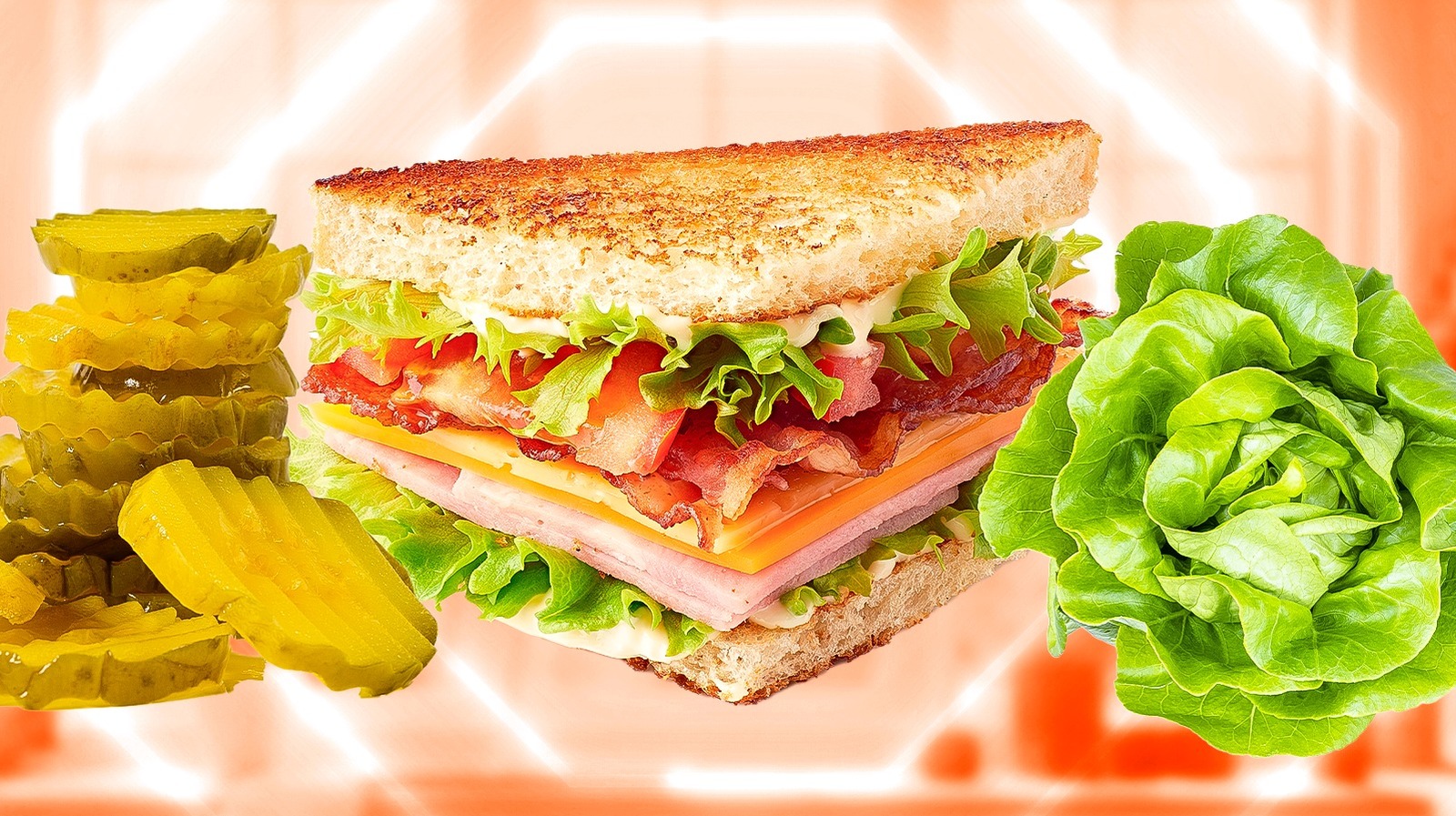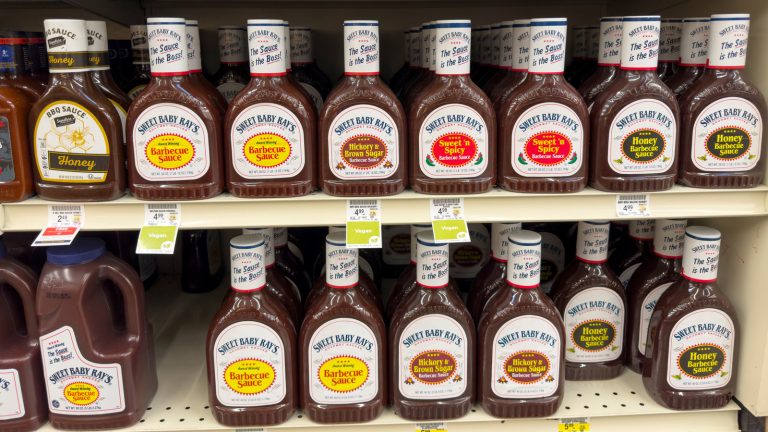The humble sandwich is a staple food for many of us, and its low-maintenance nature makes it a convenient option for adults and kids. However, if your recent lunches have been lacking the wow factor, you may not be building your sandwiches in an optimal fashion. You may assume that sandwich assembly is pretty self-explanatory — two slices of bread, a couple of ingredients for the filling, what could possibly go wrong? But poor sandwich construction can lead to all sorts of culinary carnage, from clashing flavors to textural degradation and soggy bottoms.
Recognizing the mistakes you have been making during lunchbox prep and taking simple steps to correct them can turn your lunch from a boring staple to a crunchy, tasty delight. From choosing the right bread to complementing the layers, there are many tweaks you can make to your sandwich construction technique that will make a big difference to your lunch. Stick the kettle on and join us as we unveil the common mistakes that everyone makes when building sandwiches.
Getting the wrong bread
The first step in building a sandwich is selecting the bread, but how much thought should you put into this? Most of us stick to the same bread each time, but choosing a more interesting option can transform your sandwich. Getting the texture right is also important, as heavier fillings need a more robust bread to prevent spillage. While sliced bread is the most popular option for homemade sandwiches for its pleasing texture, there are other exciting alternatives. Seeded versions offer the same soft, easy-to-eat experience but with a little added texture and flavor. With this type of bread, the main flavor stems from the filling, so make sure to pack it with tasty ingredients.
Crusty loaves create a unique mouthfeel and significantly upgrade your sandwich, as long as the bread and fillings complement each other. Ciabatta is a nicely balanced bread that can handle juicy tomatoes or a generous slather of mayo without collapsing in fright. It works especially well with Italian cold meats or a Caprese filling with a smear of pesto. For a softer option, an authentic brioche loaf is an underrated choice that works brilliantly with fillings that have a hint of sweetness, such as turkey and cranberry or goat cheese and chutney. By switching up the bread regularly, you can ensure that your sandwiches are never in danger of becoming repetitive or boring.
Not considering when to toast
Unless you’re making a toastie or panini, it probably won’t cross your mind to use a toaster. However, slightly toasting the bread can significantly impact the overall construction of your sandwich. If you have ever experienced a soggy sandwich that goes limp as soon as you lift it from the plate, you will understand how handy it would be to add a little extra strength to the creation. Bread that has visited the toaster, sandwich press, or hot pan will have a drier texture. As a result, it can hold wet fillings, like silky sauces, condiments, and juicy veggies much better. It truly pays to toast the bread for a sandwich, and you should not skip this step.
However, if you are concerned about eating a sandwich with a crispy texture, note that the filling will likely soften the bread. This means only the outside will remain crispy, creating a great contrast with each bite. It goes without saying that not every sandwich you make will require heat. Sandwiches with relatively dry fillings, such as tuna, cheese, or egg salad, complement soft, pillowy breads, so there is no need to upset the balance via toasting.
Misjudging the amount of filling
There is nothing more disappointing than eagerly biting into a sandwich only to find it has insufficient filling. When the ratio of bread to filling is too high, a mouthfeel will be all wrong, resulting in a dry and unappetizing lunch. Conversely, creating a towering sandwich comprising 80% filling also has its drawbacks. Every bite will seem like a mission to prevent the filling from spilling all over your hands and probably down the center of your clean shirt. So, how can you find the sweet spot?
Rather than getting out a ruler to calculate sandwich percentages, use your sammy intuition and a bit of visual judgment. For most people, the perfect ratio of filling is the same size as each slice of bread or up to double that volume. Any less, and it’s not really a sandwich, and too much, and you will struggle to comfortably take a mouthful without spillage. The perfect sandwich is comfortable to hold, and each bite is satisfying. It should also only take a few seconds to quickly clean up all the delicious evidence before you head back to work.
Leaving too much dry bread around the edges
The first bite of a sandwich sets the tone for the eating experience, and when it is 90% dry bread, it will not bode well for a satisfying lunch. This is why it is crucial to consider where your filling ends to avoid unbalanced bites. When layering your sandwich, make sure the filling reaches the edge of the crust, starting with the condiments or spread. Most of us add a dollop of mayo or mustard to the center of the bread, spreading outward. However, if it doesn’t quite reach the edges, be sure to reapply to cover the dry sections.
Continue this process with the rest of the layers, including veggies, protein, and any extra toppings for texture. In addition to improving the taste of the sandwich, the extra filling will protect the bread from drying out, meaning that the texture will massively improve. While the center of the sandwich is usually the most satisfying, this doesn’t always have to be the case. With careful preparation, every single bite can contain the perfect balance of ingredients.
Assuming you always need bread on top
While the sandwich has a pretty standard formula, it doesn’t mean you can’t go against its conventions. For example, who says a sandwich needs to have two slices of bread? An open-faced sandwich is unique and effortless, but depending on the filling and occasion, it can be an excellent way to jazz up the casual dish without too much struggle.
That second slice of bread that finishes off a sandwich works perfectly well with standard fillings such as cheddar and tomato or chicken and mayo. However, if you are going for more gourmet ingredients, it can often infringe on the flavor and texture. A slice of artisan bread topped with smooth cream cheese, a silky slice of smoked salmon, and buttery avocado on top is perfect — a second slice of bread will crush the filling and spoil the beautiful texture of those ingredients.
People happily order open-faced sandwiches in a restaurant for brunch, but there is no reason you can’t make it at home. Sure, they are not as convenient for a quick lunch at your desk, but if you enjoy presenting dishes beautifully and have time to savor your sandwich properly, consider this snack option. Here are some open-faced sandwiches from around the world to add a gourmet touch to your usual lunch.
Overdoing the wet ingredients
No one likes a dry sandwich, but if you go the other way and pile too many wet ingredients into the filling, you are in danger of creating a lunch that is virtually impossible to pick up. Many of the ingredients that add a real punch of flavor to fillings are wet, so it is important not to get carried away in your quest for a flavor-packed snack. One possible tactic to retain your desired quantity of delicious condiments without affecting the integrity of your lunch is to build the sandwich thoughtfully.
Rather than spreading mayo, mustard, or dressing onto both slices of bread, add them to the top of the filling after everything else has been assembled. This will protect the bread at the bottom, which is most likely to give way when you lift the sandwich to consume. Remember that some veggies, particularly tomatoes, produce juices when cut, so keep them on top of other ingredients. If you really need to slather the sandwich with a flavor enhancer, pack it in a separate container. This allows you to add it at the last minute, keeping the stability of your sandwich intact without compromising on flavor.
Missing out on contrasting textures
If you are getting a bit fed up with the usual ham and cheese sandwich, there is a crucial component it may be missing — texture. A soft sandwich can be satisfying now and then, but the same boring texture can become a bit predictable. So, add contrasting textures to the sandwich for an exciting crunch that will make all the difference. Taking this route doesn’t need to be difficult or time-consuming and can encourage you to add healthy ingredients to your lunch.
Crispy lettuce leaves, juicy cucumber slices, or colorful raw bell pepper chunks will all contribute a more exciting texture, as well as create a burst of fresh flavor. Additionally, combining these with a smooth, silky component such as cream cheese or hummus contributes a creamy element. This means a beautifully balanced sandwich is just a few ingredients away. For an extra burst of taste and texture, add some crispy onions at the last minute for a brilliant umami twist.
Layering incorrectly
Even after you have chosen the best possible combination of ingredients for your epic sandwich, there is still work to be done in building it. Throwing the different ingredients onto the bread in whatever order you feel like is not the recipe for lunchtime excellence. Taking a few extra minutes to consider the order of your ingredients tower will pay off once you take your first gratifying bite.
If presentation is a big factor for your sandwich, it pays to mirror the layers as you build. Have the same garnish above and below the main attraction in the middle. Placing two slippery ingredients consecutively increases the chances of the filling bursting out when you bite in. So, create friction between those layers with something crunchy or crispy.
If you are adding multiple wet elements, split them between the other layers to prevent them from melding together and resulting in the dreaded soggy sandwich. Finally, if you are struggling to work out how to combine all the various layers into your sandwich, consider paring it back a little. If the sandwich is far too large, eating it will go from being fulfilling to downright difficult, so choose the key layers and save the rest for tomorrow’s lunch instead.
Forgetting to add a barrier to the bread
As you gaze at the two pristine slices of bread staring back at you, there is one crucial question to answer: to butter or not to butter? While that may be down to personal preference, there is a structural reason to butter your sandwiches every time. Adding butter to bread can protect it from soaking the juices from tomatoes, cucumbers, and other wet ingredients that threaten to ruin your gourmet creation.
While widely available, butter is not the only way to achieve this goal. You can create a barrier with a thick spread of mustard, mayonnaise, or hummus, depending on the condiment that complements the filling. If you don’t enjoy spreads on your bread, consider adding solid ingredients, such as meat or a firm slice of cheese, to the bottom slice of bread. This allows it to soak up the juices and runny sauces seeping from the ingredients on top. It also helps keep the sandwich clean and prevents the bread from yielding to the weight of the toppings.
Preparing it too early
One of the best things about a sandwich for lunch is its portability. It makes sense, then, that the Smithsonian Magazine notes that 49% of Americans over the age of 20 eat a sandwich every day. Based on this data, we can assume that millions of sandwiches are being prepared hours in advance. The problem with this is that the more time your sandwich spends assembled, the lower the standard will be, creating a time-quality quandary if you want the best possible result.
Obviously, if you are eating at home and preparing your sandwich, you have the luxury of getting the timing spot on. Prepare it just far enough in advance to allow the flavors to mingle without creating a soggy, mushy mess. However, if you are creating a packed lunch for yourself or your family, a little strategic planning is required.
Ideally, keep the wet elements in separate containers, such as runny sauces and fresh and juicy tomatoes, from the sandwich until you are ready to eat. If this isn’t an option, follow the layering rules to keep them away from the bread and each other to keep the sandwich structure intact. To transport the sandwiches, resist the urge to wrap them in plastic or place them in a plastic bag. This can cause them to sweat, worsening the moisture issue. Instead, store them in an airtight container and keep them as cool as possible until you are ready to tuck in.
Forgetting to season
Every keen home cook knows that seasoning is the key to a tasty dish, and yet it is an element we often miss out on when constructing a sandwich. Your tomatoes need salt and pepper just as much on a sandwich as they would in a salad; skipping this step will result in an underwhelming sandwich.
You can season individually or as a whole, but be sure to consider how well these ingredients work together. If you are incorporating salty elements, such as ham or feta cheese, you need not add salt; choose other flavorings instead. Fresh herbs, dried chili flakes, or a squeeze of lemon juice can all elevate your sandwich ingredients, so take the opportunity to be creative and get the most out of them. Seasoning is the crowning glory of a sandwich that unites and elevates the ingredients. Next time you are building your bread masterpiece, don’t forget to include this crucial step.





